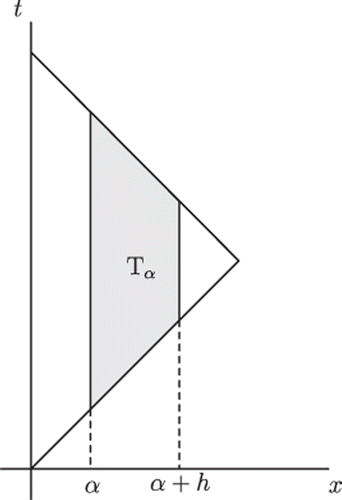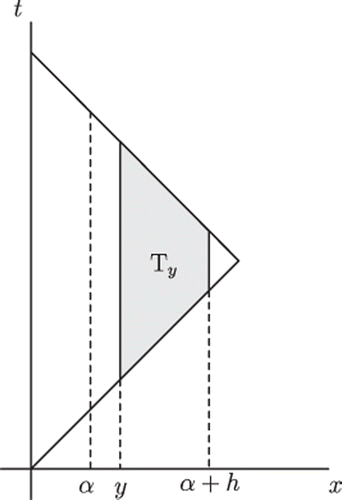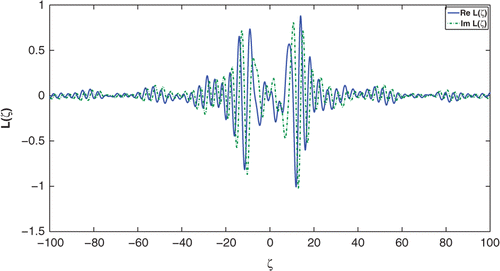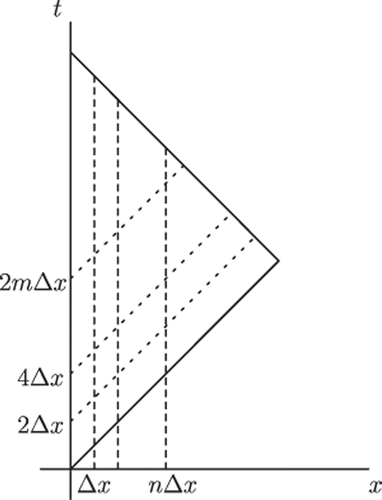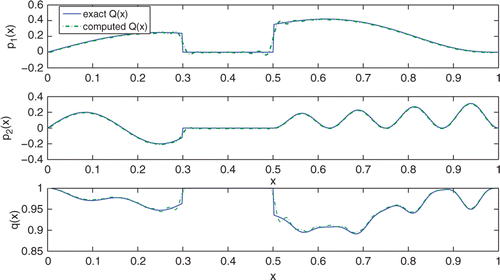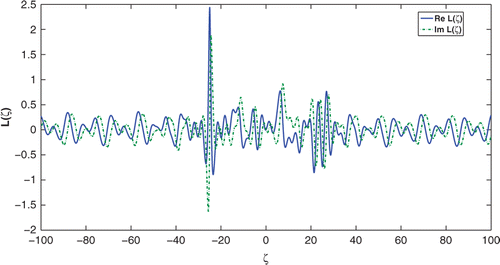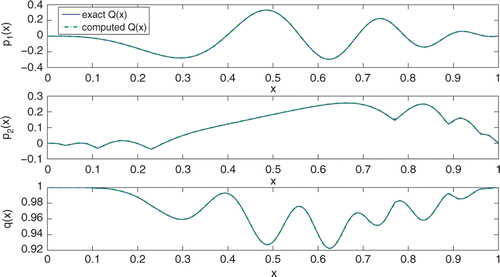Abstract
In this article, we present a direct approach to the Landau–Lifschitz scattering problem. A special fixed point problem is derived, which must be satisfied by the solution of the inverse scattering problem. A uniqueness result under a certain regularity condition is given and numerical methods based on the fixed point iteration and the layer stripping method are presented and illustrated.
1. Introduction
Let
where p1, p2 and q are real-valued functions on ℝ satisfying
and p* is the complex conjugate of p. We are interested in the problem of recovering Q(x) from scattering data, which is defined as follows in terms of special solutions of
(1)
Suppose that Q(x) is smooth enough and converges sufficiently rapidly to
as x → ±∞. Then the matrix Jost solutions J± are defined to be the solutions of (1.1) having the asymptotic behaviour
There then exists a transition matrix 𝒯(ζ) satisfying
The left and right reflection coefficients are defined on the real line as
Although in general a(ζ) may have zeros on ℝ, throughout this article we make the technical assumption that
A bound state is a square integrable vector solution to (1.1) which can occur only if ζ = ζn is a zero of a(ζ) in ℂ+, the upper half of the complex plane. Corresponding norming constants Cl,n, Cr,n are also defined as
The inverse scattering problem is to recover Q(x) from the left scattering data {L(ζ), ζn, Cr,n} or the right scattering data {R(ζ), ζn, Cl,n}. We refer the reader to Citation1 for full treatment of this problem.
A principle motivation for consideration of this problem is that it is associated as part of a Lax pair with the Landau–Lifschitz (LL) nonlinear evolution equation
(2)
arising in ferromagnetism Citation2,Citation3, hence we will refer to it as the LL inverse scattering problem (LLISP) and (1.1) as the LL system. In particular, analytical or numerical results for LLISP will have corresponding implications for the theory or computation of solutions of (1.2).
In this article, our main interest is in certain computational techniques for LLISP. The most common analytical methods, as in most other one-dimensional inverse scattering problems, involve integral equations of Gelfand–Levitan or Marchenko type, and numerical methods can be derived based on these. An alternative, which we investigate here, is to replace LLISP by an equivalent overdetermined problem for a hyperbolic system. Such an approach has been developed in the case of the scalar Schrödinger inverse scattering problem (see, e.g. Citation4) and leads to fast and stable numerical methods. A similar technique was developed for use in connection with a simpler system (see (1.3) below) in Citation5, but details were not given there.
It is known starting from the work of Citation6 that LLISP is related to the more well-known inverse scattering problem (ZSISP) for the Zakharov–Shabat (ZS) system
(3)
where
which is in turn connected to the cubic Schrödinger equation via the inverse scattering transformation. Here s is a complex valued function on ℝ. We refer the reader to Citation7–11 for a comprehensive survey of the ZSISP and the general inverse scattering theory. The most refined results about the LLISP may be derived from this relationship and the known results about the ZSISP (see, e.g. Citation12). The exact connection between the two scattering problems is given by Equations (2.15a) and (2.17). Note that † denotes the Hermitian conjugate. This relationship is somewhat analogous to the correspondence between scalar scattering problems for the linear Schrödinger equation
and the impedance form equation
When the coefficients are sufficiently smooth a straightforward change of variables transforms one equation to the other, and likewise the scattering data are related in a simple manner. However the correspondence is that
so that in cases of low regularity the transformation may be difficult to work with (e.g. η ∈ H1) or may break down entirely (η ∈ L∞ or even BV). Similarly, differentiability or at least absolute continuity of Q is required for the transformation of the LLISP to the ZSISP.
It is hence of interest to study the LLISP directly, rather than rely on theory of the ZSISP. Also, a direct method for numerical solution of the LLISP could be a useful device for numerical solution of the ZSISP. Our main quests in this article are
| • | derivation of a computational method for the LLISP and | ||||
| • | analysis and numerical simulation of our method. | ||||
Under these assumptions we derive two different overdetermined hyperbolic boundary-value problems connecting the coefficient matrix Q to the data L in a manner which is convenient for calculation. We also show that there is a unique solution which is absolutely continuous when L(ζ) satisfies a certain condition. Numerical examples, however, show that our method is not restricted to this case, that is, we successfully reconstruct discontinuous Q as well. Mathematical analysis of cases of piecewise continuous Q is ongoing work.
The outline of this article is as follows. In Sections 2 and 3, we derive two overdetermined boundary-value problems, which we will refer to as time-domain problems I and II, both of which are equivalent to the inverse scattering problem for the LL system (1.1) under the additional assumptions stated above. Problem I will exhibit explicitly a form of the known connection to the corresponding inverse scattering problem for the ZS system. Problem II is somewhat simpler in appearance, although not necessarily simpler to analyse, and is more suitable for use in cases of low regularity Q. In Section 4, we investigate the direct problem of the hyperbolic system and present auxiliary results. A fixed point problem is derived, which is equivalent to time-domain problem II in Section 5. We show that they have unique solutions as well. In the last section, we give numerical examples based on the fixed point iteration and the layer stripping method.
2. Time-domain problem I
Here, we derive the first of the two overdetermined hyperbolic boundary-value problems. As mentioned earlier, we assume that Q has no bound states and Q − Λ is supported in [0, ∞). We further assume that Q is sufficiently smooth for the moment. Applying the Fourier transform to the LL system (1.1) yields
(4)
where
If the initial condition
(5)
is assumed, the boundary condition for (2.1) is given by
(6)
Indeed, since u(1)(x, t) is an incoming wave from the left, u(1)(x, t) = 0 for x < 0 and t ≠ x. Thus
Note that u(1)(x, t) is continuous on {t > x} because Q is assumed to be sufficiently smooth.
We seek a suitable additional boundary condition for (2.1) at x = t so that it is an overdetermined problem. To this end, we use the propagation of singularity for the wave equation (see, e.g. Citation14,Citation15). Let { fk(x)} be a sequence of functions,
so that
The solution of (2.1) and (2.2) with Q(x) = Λ is
, thus near the characteristic t = x we should have
(7)
Inserting these expansions into (2.1) and matching the coefficients of the most singular terms we get
(8)
and the coefficients in subsequent terms,
(9)
From the conditions (2.2) and (2.3), we set
(10)
(11)
Now we show the uniqueness of u0 satisfying (2.5) and (2.7). Multiplying (2.6) by , the Hermitian conjugate of u0, for k = 1 yields
(12)
(13)
and thus |u0| = 1 from (2.7). Suppose that v is a column vector satisfying (2.5) and (2.7). Then v = e−iθ(x)u0 for a real-valued function θ(x) such that θ(0) = 0. It follows that
which implies v = u0.
Next, we compute u1. Since is orthogonal to u0, there exist scalar functions
such that
(14)
We substitute this representation into (2.6) for k = 1 to obtain
Similar to (2.10), applying
to (2.6) for k = 2 yields
Then we have the following differential equation due to the representation of (2.11).
The initial condition is obtained from (2.7), (2.8), (2.10) and (2.11). From the integration by parts
and
(15)
Thus
(16)
It follows from (2.4) that the additional boundary condition is given by
Now we introduce Problem I based on above argument as follows.
Time-domain problem I for the LLISP (TD1)
Given L = L(ζ), determine Q = Q(x) such that there exists u satisfying
(17)
(18)
(19)
Here Q and u1 are related in the following manner:
| 1. | Solve the differential equation (2.13) for | ||||
| 2. | Compute u0 from (2.12). | ||||
| 3. |
| ||||
One way to see that Q may be uniquely determined by means of (TD1) is to make a connection to a corresponding problem for the ZS system, provided that Q is sufficiently smooth. Let F = F(x) denote the solution of
(20)
(21)
and set v = F†u. One may then check that
(22)
(23)
where
(24)
In addition,
It follows from (2.17) that
(25)
The equations (2.16a), (2.16b) and (2.18) amount to a overdetermined hyperbolic boundary-value problem for v(x, t), which is already known in the literature, which may be used to recover S(x). For example in Citation16 it is proved that
is uniquely determined on [0, X] from knowledge of
on [0, 2X]. A direct analysis of (TD1) could be given, but we will instead derive an alternate problem in the next section, and analyse that one more closely.
Finally, we remark that this connection between these two overdetermined hyperbolic problems is parallel to, and predictable from, the earlier known results connecting the LLISP and ZSISP, and those connecting (1.2) and the cubic Schrödinger equation.
3. Time-domain problem II
In the time-domain problem 1 above, the direct relation between Q and u1 is somewhat complicated. Furthermore, the boundary data at x = 0 may be difficult to work with if Q has a low regularity. Indeed,
for some discontinuous Q. Thus, we are motivated to construct a more transparent system which is equivalent to (2.14) and which may be more easily used in the case of low regularity boundary data and Q. This can be done by a simple change of variables.
We define
After some straightforward calculations using (2.6) and (2.14), we obtain
Clearly
(26)
and since u0 is a normalized eigenvector of Q corresponding to the eigenvalue 1, (3.1) can be rewritten as
Hence, we have the following time-domain problem.
Time-domain problem II for the LLISP (TD2)
Given L = L(ζ) determine Q = Q(x) such that there exists w satisfying
(27)
(28)
(29)
Note that implies that
(30)
assuming w(1)(x) ≠ 0 and q(x) ≠ −1.
We note that the additional boundary conditions (3.2c) (or (3.3) have an obvious sense even for discontinuous Q.
4. Direct problem
In this section, we discuss the well-posedness for (3.2a)–(3.2b) and investigate properties of solutions under various conditions for . We rewrite (3.2a)–(3.2b) on the domain T which is bounded by x = t, x = 0, and t = 2X − x.
(31)
(32)
Here we do not limit w0 to the form of (3.2b).
The well-posedness of (4.1) is a well-known result for smooth enough Q and w0. For the case of less regularity, we define a weak solution;
Definition 1
w ∈ L2(T) is a weak solution to (4.1), provided for any smooth vector function ϕ(x, t) such that ,
(33)
Recall that we say a vector function (or a matrix function) w is in L2, if |w|, the standard matrix 2-norm is in L2 and V(w;(a, b)), the total variation of a vector function w over (a, b), is defined as
We now state the well-posedness for the direct problem (4.1) as follows.
Proposition 1
Suppose that Q ∈ L2(0, X) and w0 ∈ L2(0, 2X). Then there exists a unique weak solution w ∈ L2(T) to (4.1) such that
(34)
Moreover, if
then w ∈ W1,s(T) such that
(35)
and if w0 ∈ BV(0, 2X) then
(36)
The proof can be found in the appendix. We close this section by stating two lemmas which will be used in the next section.
Lemma 1
Suppose that w solves (4.1) for given Q ∈ L2(0, X) and w0 ∈ W1,1(0, 2X). Then w, the trace of w at t = x, belongs to L1(0, X) ∩ L∞(0, X) and is such that
(37)
Here C is independent of Q.
Proof
The fact that w ∈ L1(0, X) follows from Proposition 1 and the standard trace theorem. We consider w(x, ·) for fixed x to show that w is bounded. Since
then from the embedding theorem, w(x, ·) is continuous up to the boundary of the interval (x, X − 2x) and there is a constant C, which is independent of x and Q, such that
Hence we obtain (4.6).▪
Lemma 2
For given w0 ∈ W1,1(0, 2X), define
Then 𝒲 is equicontinuous over [0, X].
Proof
First, we assume that w0 ∈ W2,1(0, 2X). Then wt solves (4.1) with boundary data . As a corollary of Lemma 1
Since Q is bounded, wx(x, x) = −Q(x)wt(x, x) is also in L∞(0, X). It follows that w is differentiable and
(38)
This implies that w′ is uniformly bounded since the constant C is independent of Q. For the case that w0 ∈ W1,1(0, 2X), we consider a sequence {w0,n} ⊂ W2,1(0, 2X) converging to w0 in W1,1. Since wn, which is the trace of the solution wn corresponding to w0,n, uniformly converges to w due to (4.6), we obtain the desired result.▪
5. Fixed point problem
We next propose and study a direct approach to (TD2) by recasting it as a fixed point problem. Fix X > 0 and let
For given w0, we define an operator ℒ as
(39)
where
is the trace of the solution w to Equation (4.1) with Q given by
One may check that for w0 ∈ W1,1(0, 2X), ℒ is a well-defined map from Z to itself from Lemma 1 as long as
(40)
We now observe that (TD2) is equivalent to the fixed point problem for the operator ℒ for
(41)
under certain regularities on
. From direct calculation, we have
(42)
Hence q is a fixed point of ℒ in Z if and only if the characteristic boundary condition (3.2c) holds, provided the condition (5.2) is satisfied.
Proposition 2
For given L(ζ), Q solves (TD2) if and only if the corresponding q is a fixed point of ℒ with w0 defined in (5.3), provided
We remark that under certain properties on L(ζ), one can show that
(43)
if either Q solves (TD2) or q is a fixed point of ℒ. Indeed, as a corollary of Lemma 3, one can see that (5.5) holds if Q solves (TD2) for
. The other case follows from Theorem 1 as well.
Lemma 3
Suppose that w solves the overdetermined boundary-value problem (4.1) and (3.2c) for Q ∈ L2(0, X) and w0 ∈ W1,1(0, X) such that and
(44)
Then
Proof
Let w0,n ∈ W2,1(0, 2X) be a sequence converging to w0 in W1,1 such that
(45)
satisfying (5.6). Since w is continuous due to Lemma 2 and wn, which is the trace of the solution wn corresponding to w0,n, uniformly converges to w due to Lemma 1, it is sufficient to show that
From direct calculation, we have
Then from (4.7) and (3.2c), we obtain
which yields the desired result.▪
Next we turn our attention to the existence and uniqueness of a fixed point of ℒ. Due to the condition (5.2), ℒ(q) may not be in Z in general. For this reason, we analyse the fixed point problem locally. Namely, we consider a local map ℒα over the domain Tα () for each α ∈ [0, X) and some fixed h > 0. ℒα(q) is given by (5.1) for q in Zα, which is a projection of Z over [α, α + h], and w is the trace of w satisfying (4.1a) in Tα with the boundary condition
for given wα(t). Note that we regard h as X − α in the case of α > X − h.
Lemma 4
For given α ∈ [0, X), suppose that wα(t) ∈ W1,1(α, 2X − α) and is of bounded variation such that
(46)
and for some constant M
(47)
Then there exists h > 0, which depends only on M, such that ℒα is a contraction mapping from Zα to itself.
Proof
Fix h = h1 > 0. Since w is continuous on [α, α + h1] from Lemma 2, ℒα(q) ∈ Zα provided |w| ≠ 0. Indeed, this is the case. Due to the assumption (5.8) and Lemma 2, we can take 0 < h2 ≤ h1 such that
(48)
Thus ℒα is well-defined from Zα to itself for h = h2. We note that h2 depends only on
thus M.
Next we show that ℒα is a contraction map by re-defining h other than h2 if necessary. Let p, q ∈ Zα, P, Q be the matrices corresponding to p, q, respectively, and w(x) = w(x,x), v(x) = v(x, x). Here w(x, t), v(x, t) solve the following equations over Tα.
We deduce that
(49)
To estimate |w − v|, we assume that wα ∈ W2,1(α, 2X − α) for the moment. Let u = w − v and R = P − Q. Then u(x, t) solves the following problem over Tα,
By Duhamel's principle, u is given by
where K(x − y, t, y) solves
Here Ty is a subdomain of Tα (). Note that R(y)vt(y, ·) is in W1,1(y, 2X − y) for almost every y due to Proposition 1. Moreover, (4.4) implies that
For any x ∈ [α, α + h2],
For the last inequality, we use (4.4) again. It follows from the Sobolev embedding theorem that for some constant C which is independent of x and α,
Hence, together with (5.10) and (5.11), we obtain
We re-define h as
so that
(50)
For the case of wα satisfying the assumption in the lemma, we consider a sequence {wα,n} ⊂ W2,1(α, 2X − α) converging to wα in W1,1 such that for some N1
(51)
Such a sequence exists because the total variation of
is assumed to be bounded. Let
and ℒα,n be the map over [α, α + h] corresponding to wα,n. Then ℒα,n converges to ℒα uniformly since wn uniformly converges to w due to (4.6) for any given q. Here wn is the trace of solutions wn corresponding to wα,n. Hence, for any ϵ > 0, there is N2 such that for any q ∈ Zα
(52)
Then for n ≥ max{N1, N2}
Hence ℒα is a contraction mapping over [α, α + h].▪
Now we state the existence and uniqueness of the fixed point for the global operator ℒ.
Theorem 1
Suppose that w0 ∈ W1,1(0, 2X) and is of bounded variation satisfying
Then the corresponding operator ℒ has a unique fixed point in Z. Moreover the fixed point is continuous.
Proof
Let
Then, there exists h > 0 such that ℒ0 has a fixed point in L2(0, h) due to Lemma 4. By the construction of the fixed point, w(x) is continuous and |w(x)| ≥ 1/2 on [0, h], which is the trace of the solution w(x, t) of (4.1) with the corresponding Q. It follows from (5.4)
that is, (w, Q) solves the overdetermined boundary-value problem (4.1) and (3.2c) over [0, h]. Lemma 3 implies that |w(x)| = 1 for all x ∈ [0, h]. Now we consider ℒh with the boundary condition
Since
and
due to Proposition 1, we can find a fixed point of ℒh over [h, 2h]. We continue this procedure to find a fixed point q of ℒ over [0, X]. Since h is independent of x, the induction step terminates in a finite number of steps.
The continuity of the fixed point follows from Lemma 2.▪
As a corollary of Proposition 2 and Theorem 1, we have the following uniqueness result for the LLISP.
Corollary 1
Suppose that there are no bound states for LLISP with Q such that Q − Λ is supported in [0, ∞). Then Q is uniquely determined on [0, X] from the knowledge of on [0, 2X] if
(53)
In this case, Q is continuous on [0, X].
We remark that it is possible to solve the half line LLISP without bound state information by a Darboux kind of transformation similar to the ZSISP described in Citation5. Indeed, assuming that Q − Λ is supported in the right half line, the left reflection coefficient can uniquely determine the bound state data {ζn, Cr,n}. Then
is the left reflection coefficient for Q[0] without bound states and Q can be uniquely restored from Q[0]. The case without a support assumption can be handled as well by a splitting method using step-like coefficients. For given Q, we split it to Ql, Qr such that
Then one can extract the right reflection coefficient for Ql and the left reflection coefficient for Qr from the relation
Here 𝒯l, 𝒯r are the transition matrices corresponding to Ql, Qr, respectively. For more details we refer the reader to Citation12.
6. Numerical methods
In this section, we illustrate two numerical methods for (TD2). The first is based on fixed point iteration for the mapping method described in the previous section, and the second is a layer stripping method.
shows a numerical example of p and q reconstructed on [0, 1] from the fixed point method after eight integrations. The residual norm at each iteration is given in . In this example, Q is chosen so that , a condition known to guarantee that there are no bound states as mentioned in Section 1. To obtain the sampled left reflection coefficient L(ζj) for ζj = jΔζ, j = −M, … , M, we solve the LL system
by an ODE solver. Then L(ζj) is given by
shows the sampled left reflection coefficient L(ζ).
Table 1. Residual norm at each iteration step.
In computing the boundary data , we used the simple trapezoid rule after computing
by the fast Fourier transform algorithm with zero padding L(ζj) values to the interval of [−(M + M′)Δζ, (M + M′)Δζ]. In the contraction mapping method, we have to solve the hyperbolic system (3.2a)–(3.2b) at each iteration step. For this, we adopt the idea in Citation17. We deduced that
(54)
(55)
Consider the mesh points described in
We obtain finite difference equations for (6.1) along the characteristic lines by the first-order backward scheme,
(56)
(57)
Here wn,m = w(xn, tn,m), pn = p(xn), and qn = q(xn). Let
Then (6.2) yields
where A · B denotes an entrywise product. We remark that An is invertible as long as qn ≠ −1. Since we assume that the actual Q satisfies that
, it is reasonable to assume that qn > −1 at every step. Note that for all the examples given in this section, we choose M = 104, M′ = 106, Δζ = 0.01, Δx = 0.002 and q = [0 1]T as the initial guess.
We applied this method to a discontinuous Q although our theory is restricted to continuous Q and there is a non-uniqueness result for the LLISP with discontinuous Q Citation12. Moreover, the corresponding may include Dirac delta functions in this case so that
is not satisfied anymore. Nevertheless, our method can successfully reconstruct Q as shown in . The corresponding scattering data, the left reflection coefficient is shown in .
Next we illustrate a layer-striping method to solve (TD2) directly. Suppose that pj, qj are already reconstructed for j ≤ n − 1. Then we can find wn,m (m = 0, 1, 2, …) from the following equation derived by the first-order forward method.
Then pn, qn are computed as
Since p0 = 0 and q0 = 1, we can construct pn, qn for all n by the induction.
shows a numerical example via the layer-striping method described above.
Acknowledgments
The author would like to thank Professor Paul Sacks for helpful discussions. A part of this article is presented in the author's Ph.D thesis.
References
- Faddeev, LD, and Takhtajan, LA, 2007. Hamiltonian Methods in the Theory of Solitons, Classics in Mathematics. Berlin, English ed.: Springer; 2007, (Trans. from the 1986 Russian original by Alexey G. Reyman).
- Takhtajan, LA, 1977. Integration of the continuous Heisenberg spin chain through the inverse scattering method, Phys. Lett. A 64 (2) (1977), pp. 235–237.
- Fogedby, HC, 1980. Solitons and magnons in the classical Heisenberg chain, J. Phys. A 13 (4) (1980), pp. 1467–1499.
- Bayliss, A, Li, YY, and Morawetz, CS, 1989. Scattering by a potential using hyperbolic methods, Math. Comput. 52 (186) (1989), pp. 321–338.
- Sacks, P, and Shin, J, 2009. Computational methods for some inverse scattering problems, Appl. Math. Comput. 207 (1) (2009), pp. 111–123.
- Zaharov, VE, and Tahtadžjan, LA, 1979. Equivalence of a nonlinear Schrödinger equation and a Heisenberg ferromagnet equation, Teoret. Mat. Fiz. 38 (1) (1979), pp. 26–35.
- Lamb, GL, 1980. Elements of Soliton Theory, Pure and Applied Mathematics, A Wiley-Interscience Publication. New York: Wiley & Sons; 1980.
- Ablowitz, MJ, and Segur, H, 1981. Solitons and the Inverse Scattering Transform, SIAM Studies in Applied Mathematics. Philadelphia: Society for Industrial and Applied Mathematics, Vol. 4; 1981.
- Chadan, K, and Sabatier, PC, 1989. Inverse Problems in Quantum Scattering Theory, Texts and Monographs in Physics. New York: Springer-Verlag; 1989, (with a foreword by R.G. Newton).
- Ablowitz, MJ, Prinari, B, and Trubatch, AD, 2004. Discrete and Continuous Nonlinear Schrödinger Systems, London Mathematical Society Lecture Note Series. Vol. 302. Cambridge: Cambridge University Press; 2004.
- Shaw, JK, , Mathematical Principles of Optical Fiber Communications, CBMS-NSF Regional Conference Series in Applied Mathematics, Vol. 76, Society for Industrial and Applied Mathematics, Philadelphia, 2004.
- Shin, J, , Inverse scattering problems for the Landau-Lifschitz equations, in review.
- Klaus, M, and Shaw, JK, 2003. On the eigenvalues of Zakharov-Shabat systems, SIAM J. Math. Anal. 34 (4) (2003), pp. 759–773 (electronic).
- Bube, KP, and Burridge, R, 1983. The one-dimensional inverse problem of reflection seismology, SIAM Rev. 25 (4) (1983), pp. 497–559.
- Sacks, P, 2004. An inverse problem in coupled mode theory, J. Math. Phys. 45 (4) (2004), pp. 1699–1710.
- Rakesh, , 2001. A one-dimensional inverse problem for a hyperbolic system with complex coefficients, Inverse Probl. 17 (5) (2001), pp. 1401–1417.
- Santosa, F, and Schwetlick, H, 1982. The inversion of acoustical impedance profile by methods of characteristics, Wave Motion 4 (1) (1982), pp. 99–110.
Appendix
Here we provide the proof of Proposition 1.
First, we consider piecewise constant Q such that , where x0 = 0 and xN = X. Define a translation operator 𝒫k such as
from W1,2(xk−1, 2X − xk−1) to W1,2(Tk). Here Tk = {(x, t) ∈ T: xk−1 < x < xk}. Then the linear operator 𝒫k satisfies the following properties:
With these notations and a Hermitian matrix Fk such that QkFk = FkΛ, we define
on each Tk, where wk−1(·) = w(xk−1,·). Since for any smooth v0, 𝒫kv0 solves
w solves (4.1). Moreover, if w0 ∈ W1,2(0, 2X) is assumed then w ∈ W1,2(T) since w is continuous across x = xk. Indeed, the properties of 𝒫k yield that for any 0 ≤ α < α + h ≤ X
(58)
and especially
For general Q ∈ L2(0, X), we consider a sequence of piecewise constant Qn converging to Q. From the above argument, there is wn ∈ W1,2(T) solving (4.1) for each Qn and a fixed w0 ∈ W1,2(0, 2X). Since wn is uniformly bounded in W1,2(T), we can extract a subsequence such that
We now claim that w is a weak solution to (4.1). For any test function ϕ,
(59)
Here ⟨·, ·⟩ denotes the standard inner product on L2(T). Since
weakly converges to w in W1,2(T) and
is uniformly bounded by a square integrable function, the first and the third term on the right-hand side converge to 0 as nk → ∞. The boundedness of a weakly convergent sequence yields
which converges to 0. Since
is a solution for
,
for all nk. Thus, (6.4) implies
which gives (4.2) as desired.
Moreover, since weakly converges to wt in Ls(Tα)(s = 1, 2) for any α, h (see ), it follows from (6.3) that
Since α, h are arbitrary, we have energy estimation (4.4) for almost all x.
For the uniqueness, we have to derive an energy estimation without using the method to construct solutions. Let w ∈ W1,2(T) be a solution for Q ∈ L2(0, X) and w0 ∈ W1,2(0, 2X). By applying Stokes's theorem to over T0, we have
Since |w|2 ≥ |w†Qw|, we conclude that
which gives the uniqueness for the case of w0 ∈ W1,2(0, 2X).
The existence and uniqueness of a weak solution for a general w0 ∈ L2(0, 2X) follows from a simple change of variables. For given w0 ∈ L2(0, 2X), we define
Then above argument implies that there exists unique
solving (4.1) for the boundary data
. That is, for any test function ϕ,
since ϕt is also a test function. Integration by parts yields
Thus,
solves (4.3) for w0 ∈ L2. The energy estimation (4.3) follows from (4.4).
To derive (4.5), we consider a sequence {w0,n} ⊂ W1,1(0, 2X) converging to w0 in L2 and
Let wn(x, t) be the solution of (4.1) with boundary data w0,n. Then for any test vector function
such that
Since wn(x, ·) converges to w(x, ·) in L2(x, 2X − x), sending n to the infinity and taking supremum over all such φ yields (4.5).
